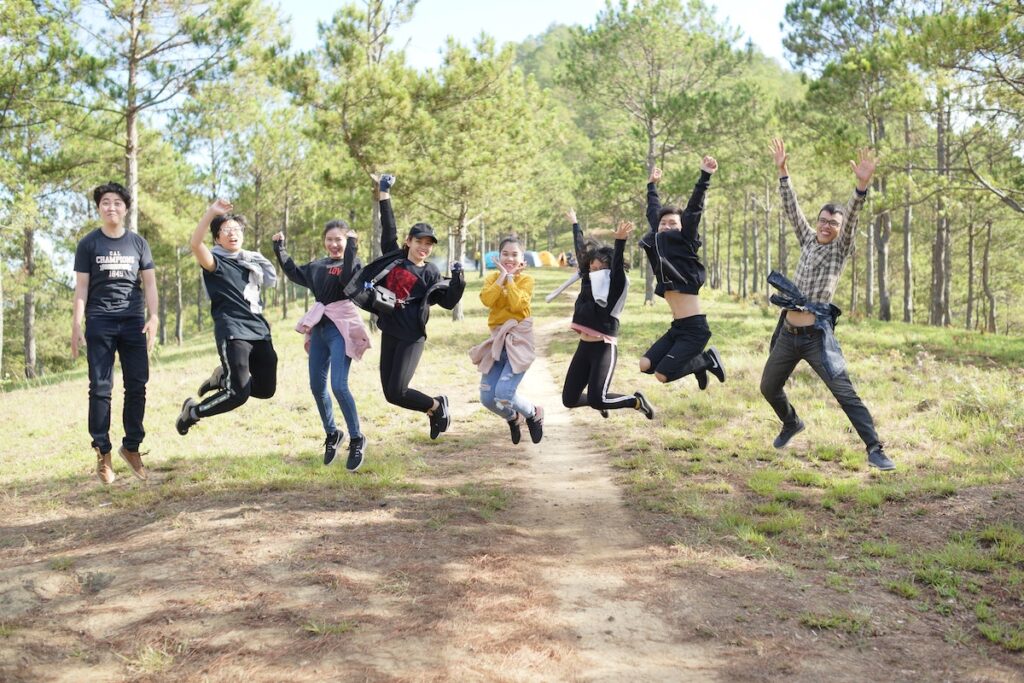
We all have a need to be part of a broader community, to feel socially connected, and to be included in social and economic activities. However, we don’t all share the same opportunities to participate in social activities and some people are prevented from feeling a sense of belonging and connectedness to their community.
Social isolation and exclusion from society is a significant cause of psychological distress and can lead to mental health problems, like depression and anxiety. The roots of social exclusion are numerous: political structures can keep some people from participating in the social life of their communities, as happens when people are denied citizenship or prevented from voting in national elections. The built environment and individual attitudes can also create barriers to social inclusion, as often happens for persons with disabilities when buildings are not accessible or when stigma prevents their meaningful participation in mainstream schools.
Indeed, social exclusion commonly results from discrimination and stigma, for example when xenophobia results in migrants and refugees being excluded from economic and social opportunities. Other kinds of prejudice, like homophobia and transphobia, can also lead to social exclusion and marginalisation, with a devastating impact on psychological wellbeing.
Finding ways to include people is an important way to prevent and treat mental health problems like depression and anxiety, particularly among adolescents, as social environments beyond the home become increasingly important during this period, and the risk of mental health problems simultaneously increases.
There is good reason to believe that social inclusion interventions will probably be most effective among marginalised groups, such as people at risk of social exclusion like young people with developmental disabilities. A recent study published in the School Mental Health journal provides an illustrative example of how social inclusion looks and feels for young people with Autism Spectrum Conditions (ASCs) and provides weight to the argument that social inclusion interventions may be a valuable strategy to employ when trying to improve outcomes among youth at risk of marginalisation and mental health problems. The study also provides a model of how research can be a platform for including young people and providing opportunities for their voices to be heard.

Finding ways to improve social inclusion is an important way to prevent and treat mental health problems like depression and anxiety.
Methods
The study by Aubineau and Blicharska (2020) aimed to understand how students with ASCs experience mainstream education in secondary schools in France and Quebec, Canada.
Part of the impetus for the study was the author’s recognition that studies on social inclusion and school inclusion among adolescents with ASCs have historically been dominated by non-autistic perspectives on what meaningful inclusion is, and so wanted to create an opportunity for experts with lived experience (autistic people) to be able to share their views.
The research was conducted with twenty-six teenagers with ASCs who were aged between 12 and 16 years. The authors included adolescents who had a diagnosis of ASC or pervasive developmental disorder (including Asperger syndrome), were enrolled full time in a mainstream secondary school in grade nine or ten, spoke French at home, and were living in France or in Quebec, Canada. The authors only selected adolescents who they described as having ‘high-functioning autism’, meaning that they were able to communicate and had IQ scores in the normal/average range.
The authors recruited the teenagers by contacting inclusive schools and asking school administrators to let teachers and families know about the study and the recruitment effort. The authors also contacted people in their knowledge networks who would be able to disseminate information about the study.
After informed consent was obtained, each of the 26 participants took part in a semi-structured interview which lasted about an hour. The interview was guided by a semi-structured interview guide, because the authors wanted to balance the desire to understand participants’ lived experiences in their own words, with the fact that young people with ASCs may find it difficult to volunteer detailed information without prompts. The questions in the interview guide were based on a systematic review conducted by one of the study’s leads. All the interviews were audio-recorded and thematically analysed. The analysis was guided by the authors’ interest in the following questions:
- What do the participants say about their current experience of school inclusion?
- To what do they aspire regarding their educational and professional ambitions?
- What are their experiences and feelings about friendship, inside and outside of school?
- How do they perceive themselves and how does autism play a role in their identity formation?
- What are the satisfactions and dissatisfactions of the participants regarding the support they receive inside and outside of school?
- What are their advice and their proposals for improvement in order to promote a more successful experience of inclusion in mainstream secondary schools?
Results
The adolescents reported that managing the sensory aspects of their condition (for instance coping with loud noises during school lunch breaks), coping with their peers’ behaviour including exclusionary behaviour and bullying, and feeling tired (in part due to the additional emotional resources required to function in the environment of a mainstream school) were all seen by young people as barriers to social inclusion and participation.
Enablers of social inclusion and participation included being included in an intensive academic programme, being ‘driven’ and feeling passionate about something, and having a friend inside the school. Students also spoke about the accommodations necessary to help them participate in school life. As one young man explained, having a computer to assist him to keep up in class allowed him to function on a more even playing field:
In fact, [with] the computer [I] would be like a penguin in water: I go really fast. And as soon as I come back to the pen: it’s like putting a penguin on the floor.
Importantly, the study showed how facets of the school environment, like accommodations in the prior example, were central to adolescents’ experiences of social inclusion in school. In another example, a young man explained that the fact that his school had a smaller class size and a programme which meant that the students remained with the same peers throughout their time in school, meant that he felt more included than his peers with ASCs who were in more typical school structures. He said:
Then, I discovered that there is a huge difference between my group and the [other] group. My group could be compared to a net: everybody knows everybody, while in the other group, there are more like ‘gangs’. For example, “YOU are not in my team because you are not in my gang.

The study showed how facets of the school environment, like accommodations, access to assistive technologies, and the way their classes and curricula were structured were central to adolescents’ experiences of social inclusion in school.
Conclusions
The findings of this study make two useful contributions, the first having to do with the content of what was found, and the latter to do with the authors’ process of generating these findings. Regarding the content of what adolescents with ASCs said about their school experiences, the study sheds light on some of the main obstacles to social inclusion and enablers of social inclusion experienced by youth with ASCs in mainstream school environments. While not generalisable, the findings certainly highlight domains of young people’s school experiences that could be targeted for supportive intervention.
Perhaps the most important contribution of the work, however, was the authors’ direct involvement of young people with ASCs in knowledge generation. By foregrounding the accounts of young people with ASCs, the study fulfils one of the oldest mandates in disability research of doing “Nothing About Us, Without Us” – a clarion call to recognise the expertise, and amplify the voices, of people with lived experience.
Particularly where issues of social inclusion, belonging, and participation are concerned, it is relevant, necessary, and important to centralise marginalised voices in knowledge generation. By doing so, this study hopefully sets an example of the kind of work necessary to make research a platform for social inclusion itself.

Particularly where issues of social inclusion, belonging, and participation are concerned, it is relevant, necessary, and important to centralise marginalised voices in knowledge generation.
Strengths and limitations
There are a range of methodological limitations to the study, some of which the authors noted and others which were stated but not explicitly reflected upon in the limitations section.
We begin with those noted by the authors: the sample is wealthy, from high income nations, and young people attending private schools are overrepresented. As such, the sample is not representative of the majority situation of adolescents with ASCs. Indeed, most young people with developmental disabilities reside in low- and middle-income countries (Olusanya et al., 2018). The authors also note that the study was limited by its inclusion only of young people with ASCs who were ‘high-functioning’ according to the researchers’ definitions (be enrolled in full-time education and have good enough communication skills to take part in an in-depth one-on-one interview).
Next, the authors only double-coded (that is, had thematic analysis conducted by two independent people) 15% of the interview transcripts. The gold standard in thematic analysis is to have two independent people code all transcripts, in order to improve the validity of interpretations of the data. Such measures are particularly important in qualitative research, where subjectivity is used in analyses.
To these limitations – all of which were identified and discussed by the authors, we would add – as observers of the study – that given high rates of out-of-school among young people with developmental disabilities, it could have been helpful for the study to examine experiences of out-of-school youth.
Secondly, the method of recruitment included one quite inclusive procedure (an email being sent to every Departmental House of Handicapped Persons (MDPH) and every regional education authority to inform them, with a summary of the research, letters for the attention of (1) the teenager and (2) the parents and a call for volunteers poster attached) but another which is slightly more open to bias (the main author also contacted their networks and explained the research and call for participants). It is not reported in the paper which method of recruitment resulted in the participants, and so it is wholly possible that all the participants came from the latter, less comprehensive recruitment strategy.
Finally, it would have significantly strengthened the study to have included young people with ASCs who have greater difficulties in functioning, rather than only ‘high-functioning’ adolescents with ASCs. Within marginalised groups such as young people with ASCs, there are still other lines along which marginalisation can occur, and degree of difficulty in functioning is one of them. The voices of people with intellectual disabilities, communication difficulties, and other limitations in functioning which can characterise or be comorbid with ASCs are omitted from this study, and from much research on ASCs.

There is a range of methodological limitations to the study, including the small sample, the lack of diversity in the sample, the recruitment strategy, and the exclusion of young people with more significant difficulties in functioning.
Implications for practice
The study authors highlight a number of implications for practice, and we summarise a selection of those here which have the greatest relevance to social inclusion,
- Firstly, input from experts with lived experience is critical, both in schools and in research: Every decision regarding teenagers should be made in consultation with them.
- Secondly, there is a need to facilitate involvement in peer activities for young people at risk of social exclusion: The adolescents in the study noted that participation in leisure and recreational activities with typical peers were valuable and allowed them to establish relationships outside of the school environment these activities (like going to acting lessons) facilitated social inclusion.
- Finally, attitude change and awareness-raising are imperative: Promoting awareness about the needs, priorities and perspectives of adolescents at risk of marginalisation like youth with ASCs is essential so that they can access the same opportunities in education, work, and social life as typical peers. Stigma and prejudice are often founded on lack of knowledge about ASCs, lack of contact with people with ASCs, and lack of exposure to the perspectives of people with ASCs. Change in attitudes requires a greater representation of people with lived experience in a variety of roles and environments.

Social inclusion can be supported by giving autistic youth the opportunity to share their knowledge both in schools and research settings, by facilitating the involvement in peer activities and by promoting attitude change.
Social inclusion and adolescent mental health: our Active Ingredients review
The study conducted in France and Canada by Aubineau and Blicharska prompted us to look more closely at the relationship between social inclusion and adolescents’ mental health. What we found began to raise a question in our minds: What does the evidence say about the role of social inclusion interventions in improving adolescent mental health, and are these kinds of interventions more effective in some contexts and for particular individuals?
We went on to conduct a stakeholder-informed, participatory systematic review of the literature to try and answer this question, working with a youth advisory group of 13 young people to identify all intervention studies which aimed to prevent or treat adolescent depression and/or anxiety by promoting social inclusion. We identified 12 studies which measured the effects of interventions on levels of social inclusion and symptoms of depression or anxiety among adolescents.
Although there are not many studies that clearly demonstrate the effectiveness of promoting social inclusion as a key ingredient of interventions to prevent or treat adolescent depression and/or anxiety, the studies that have been done show promising results that strongly suggest that this could be an important component of programmes to promote adolescent mental health.
The interventions that have been tested use a range of different strategies to increase social inclusion and reduce depression and anxiety, including social skills training, psychoeducation, and teaching life skills (such as communication skills training, information about the process of growing up, relationship building skills, gender and sexuality education, and information about substance use). Cash transfers, mentorship programmes, and youth empowerment programmes have also been shown to be effective as a means of increasing social inclusion and reducing depression and anxiety. One intervention even showed that creative writing and reading exercises could be used to promote social inclusion by normalising adolescents’ experience of struggling to find belonging and connectedness. We were not able to find any studies that investigated how changing the physical environment might be an effective way to increase access to social and public spaces, as part of an adolescent mental health intervention.
Unfortunately, many of the studies that have been done are of poor quality and show weaknesses in their study designs which make the results unreliable.
Although the available evidence does not allow us to reach firm conclusions about the effectiveness of social inclusion as a key component of adolescent mental health programmes to reduce depression and/or anxiety, there is enough evidence to suggest that this could be a novel and effective strategy which should be more extensively investigated.

There is enough evidence about the links between social inclusion and youth anxiety and depression to warrant further investigation.
Statement of interests
The authors of this blog have no conflicts to disclose.
This ‘Active Ingredients’ work was funded by a Wellcome Trust commission awarded to Dr Xanthe Hunt at Stellenbosch University. The funder of the study had no role in study design, data collection, data analysis, data interpretation, or writing of the report.
Links
Primary paper
Aubineau M, & Blicharska, T. (2020) High-Functioning Autistic Students Speak About Their Experience of Inclusion in Mainstream Secondary Schools. School Mental Health 2020 12(3), 537-555. Available: https://link.springer.com/content/pdf/10.1007/s12310-020-09364-z.pdf
Other references
Olusanya BO, Davis AC, Wertlieb D, Boo NY, Nair MK, Halpern R. et al. (2018) Developmental disabilities among children younger than 5 years in 195 countries and territories, 1990–2016: a systematic analysis for the Global Burden of Disease Study 2016. The Lancet Global Health 2018 6(10), e1100-e1121. Available: https://www.sciencedirect.com/science/article/pii/S2214109X18303097
Photo credits
- Photo by Jeswin Thomas on Unsplash
- Photo by Christopher Campbell on Unsplash
- Photo by Ivan Aleksic on Unsplash
- Photo by Chang Duong on Unsplash
